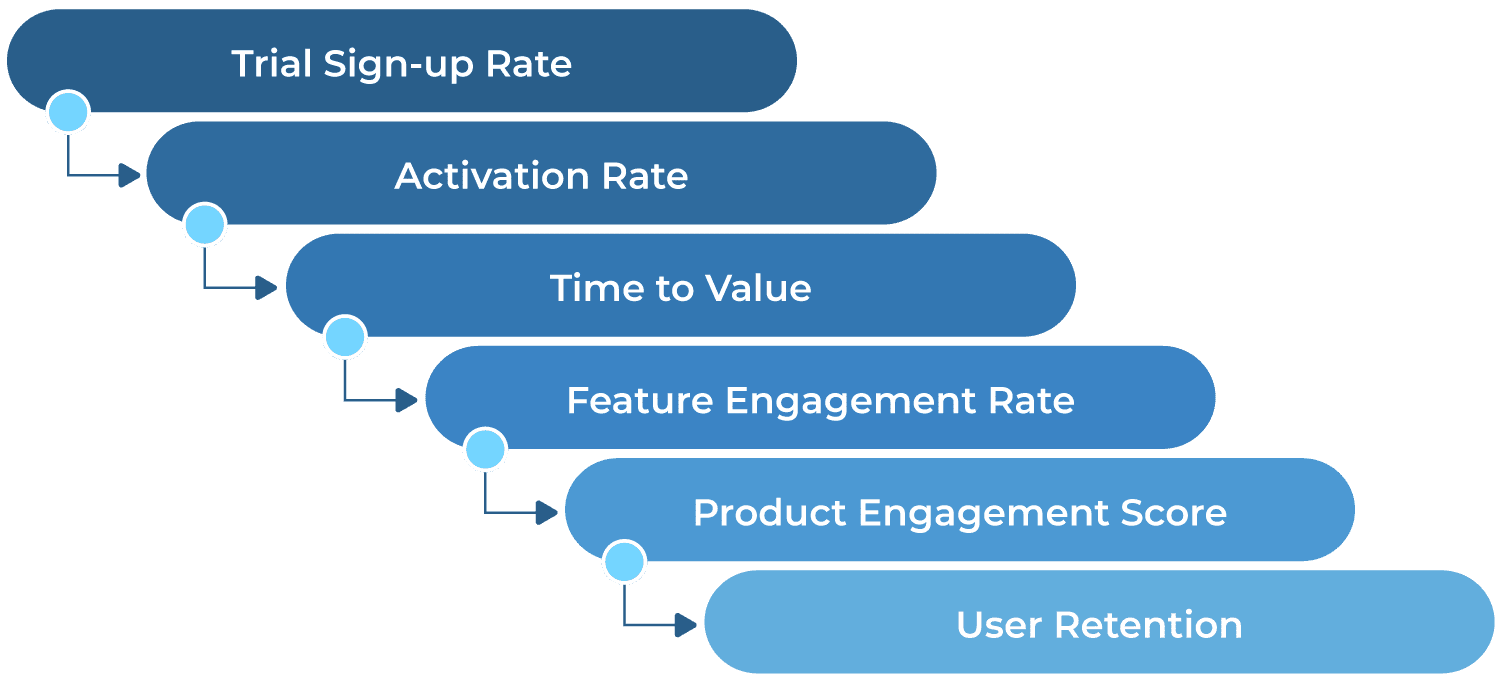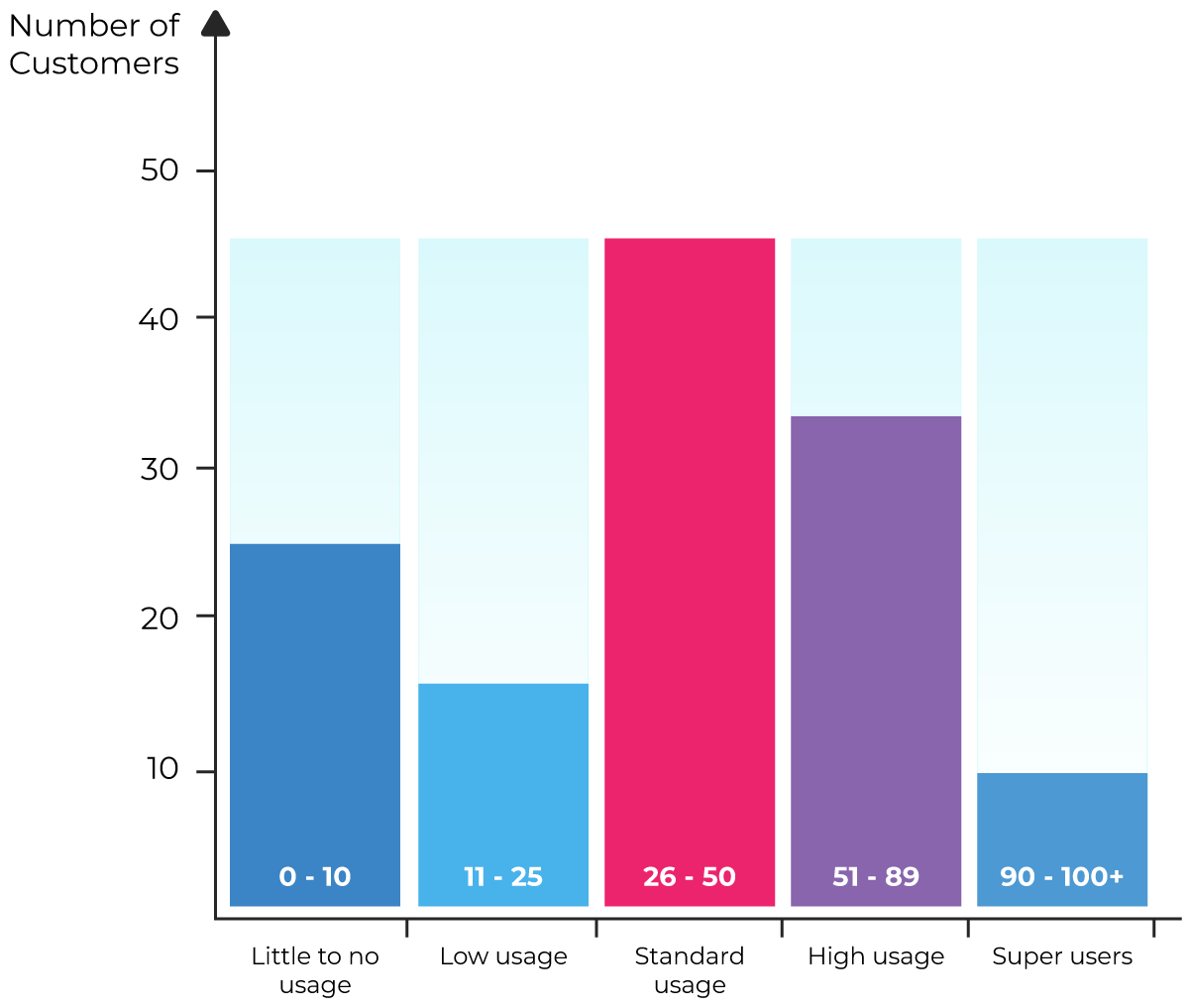Essential Product Launch Metrics: Examples & Best Practices
Measuring product performance is one of a product manager’s most important activities. However, which metrics are worth tracking depends heavily on their stage in the product lifecycle. For recently launched products, metrics like sign-up rate, activation rate, user engagement, feature engagement, and user retention matter most. Once a product matures, it becomes more important to track other metrics, like monthly active users, customer acquisition cost, and revenue.
Tracking the wrong metrics during a launch will lead to missed opportunities in assessing a new product’s value drivers. With this in mind, product managers must focus on metrics like user engagement to assess early product-market fit and optimize for success through effective segmentation and the testing of all assumptions.
Fortunately, tracking the right metrics during a product launch can be made easier with SaaS industry standards and best practices. In addition, using an analytics tool like Gainsight PX can make these tasks much more efficient. To get started, let’s review the five critical metrics you’ll need for a successful launch.
| Metric | Definition | Why this metric matters |
|---|---|---|
| Sign-up rate | (Number of sign-ups) / (number of visitors to sign-up page) | Prospective users must sign up to get value from your product, so this metric is a crucial first signal that your product is resonating with your target market. |
| Activation rate | (Number of users who perform a critical event) / (number of users who sign up) | Every product has a critical event (or series of events) that can signify the point at which a user first realizes the value of the product. |
| Time to value | Length of time between sign-up and activation | Measuring how long it takes for a customer to reach your product’s “aha moment” is critical, particularly after a launch. Identifying the tasks that require the most time and shortening them can be a helpful way to drive customers toward activation. |
| Feature usage rate | (Number of users using a feature) / (number of active users within a frame of time) | Tracking usage of individual features helps you understand which drive value for your customers and which need to be re-evaluated. |
| User health score | a*(event 1 count) + b*(event 2 count) + … | This score provides a sense of a customer’s overall usage of your product and helps identify superusers as well as positive or negative usage trends. |
| User retention | (Users at end of period – new users in period) / (Users at start of period) | Retaining users is more cost-effective than acquiring new ones. User retention is an effective way to track whether users are continuing to get value from your product. |
Product launch metrics in depth

Product launch metrics in sequence
Explanation of metrics
Below we describe each of the metrics in the table above in more detail.
Sign-up rate
The sign-up rate metric, at the very top of the funnel, must be tracked with any product launch and is relatively straightforward to measure:
![]()
To measure this rate for a specific feature, consider creating a landing page with sign-up functionality during the beta phase. If your product includes a free trial, consider segmenting your data by company to gauge an organization’s interest in your product. You should also measure your conversion rate from free to paid. As you test enhancements to your paid product, continue to measure this conversion rate to get a sense for whether the value of these enhancements is being realized during the trial period.
Tips for increasing sign-up rate:
- Ensure that you have a good reason to collect extended user information during sign-up because excess steps may cause users to abandon the process. Consider waiting until after activation to acquire additional user data.
- Capture the information needed to follow up with users who might abandon the sign-up process. Email or phone campaigns to those users may yield insights into friction points during sign-up.
- Make it easy for users to access support during the sign-up process. This makes a good first impression because users will notice the priority placed on customer service.
Activation rate
This metric tracks the percentage of signed-up users who have reached a predefined milestone, indicating the realization of value. Tracking the percentage of users who activate compared to all who signed up reveals a lot about friction in your product:
![]()
The challenge with this metric is aligning stakeholders around what that exact moment of activation is. For example, in an accounting product, activation might be the completion of an invoice.
Related metrics worth tracking include the following:
- Where in their journey users abandon a product or feature prior to reaching activation. A tool like Path Analyzer in Gainsight PX provides an easy way to understand a user’s journey through your product.

If there is any launch metric worth improving, it is the activation rate. Here are a few ways you can boost the number of users actually obtaining value from your product:
- Getting users on the path to activation as quickly and efficiently as possible is paramount. Make that path easy to find, or drop users directly onto that path after account setup.
- If your product is complex, product tours can be an effective way to guide users to activation. There are a number of products on the market that can enable this without any engineering effort.
- Interview users who fail to reach your product’s activation point. Doing so will help you segment your user base and eliminate assumptions.
Time to value
Time to value (TTV) is the length of time that it takes a user to understand the value of your product or feature. If it takes your users a long time to realize value, they are less likely to adopt your product. This metric measures time from sign-up to reaching the “aha moment”:
Activation timestamp – Signup timestamp
Here are some tips for improving time to value:
- Introduce users to your product through in-app experiences like product tours. In-app guides help orient users and scale faster than customer success initiatives that assist over the phone.
- Understand your users’ points of friction in their journey toward activation and work to eliminate them.
- Make it easy for users to get help.
Feature usage rate
Whether you’re launching a new product or a new feature in an existing product, the feature engagement rate metric indicates where to invest in your product. If users are engaging with certain features, you may be on your way to achieving product-market fit. However, if users aren’t engaging with some of your product’s features, it’s worth understanding whether those features are a necessary part of your product. This is where the feature engagement rate becomes helpful. This metric reveals the percentage of users who used a specific feature within a period of time:
![]()
*The feature engagement rate can be measured within different time frames by changing the denominator to daily, weekly, or monthly active users
There are some nuances to consider when measuring Feature Engagement Rate:
- Defining what it means to “use” the feature is important. Visits to a certain page related to the product are not equivalent to using a feature. In some cases, reuse could be a critical aspect of engagement.
- When your product is new, you must adjust your time frame accordingly. For example, directly after launch, you’ll need to adjust the formula to daily active users. After a week, you may consider updating the metric to weekly active users.
- Your definition of “active users” can also be refined to users who have taken other actions in the product or those who have been segmented by role or industry.
When preparing your product for launch, consider tracking features that differentiate you from competitors. Determine these features by asking customers and prospects why they chose your product over a competitor. If these features have low engagement, customers may not have a reason to buy your product.
If a feature isn’t a major driver of value, consider removing it. Allocate your resources toward features that users find most valuable, since those features are most likely to drive future user growth.
Here are a few ways to increase a feature’s engagement rate:
- Help users adopt your feature by making its value proposition clear in marketing, support, and the product itself.
- If a feature includes templates, consider creating sample templates showing users common use cases.
- Some features are designed with advanced users in mind. If you’re building a feature for power users, consider how you can convert other user segments to try the feature for the first time.
User engagement score
The user engagement score is a sum of significant events experienced by a single user or a segment of users and measures overall usage in a journey. Higher weights can be assigned to events with more significance, such as reaching activation, or other important milestones that occur less frequently:
a*(event 1 count) + b*(event 2 count) + c*(event 3 count)…
Note that this metric is not a ratio but an integer. With this in mind, additional metrics are often needed to properly measure success during a product launch. Graphing the distribution of the scores that your users attain will help you visualize segments of users by their level of usage. Preferably, you will have more users with high scores than low scores. Here is an example distribution of user engagement scores:

User engagement score distribution
Graphing segments of users is an important step in making sense of this metric. Groups on the right half of the distribution represent the most active users; those scoring well above the mean can be considered super users. Those on the low end of the distribution use your product seldomly or not at all. Segmenting this group into users who were active but aren’t anymore and those who were never active may help focus targeted user re-engagement campaigns.
Distributions of user engagement scores are typically less valuable directly after a product launch because your data set will be small. Start with fewer segments and keep an eye on them to see if patterns begin to emerge. As you develop a better understanding of usage patterns, break segments down into smaller groups for more fidelity.
It is worth noting that you should expect a range of scores across your user base. If all the scores seem to fall within a narrow range, consider changing which events get measured in the engagement score equation. Remember that the goal is to find product insights, not to achieve a high score.
The user engagement score is a complex yet important metric to track during your launch. Here are some steps you can take to improve scores across your user base:
- Decompose the score into its components for each user segment. Evaluate the features that are used least among low-scoring customers to understand potential barriers to adoption.
- The coefficients (or weights) of each element in the user engagement score represent the importance of the corresponding event to user engagement. When seeking to improve the score, focus on boosting events that are most important to the product’s success.
- If available, chart customer engagement scores against product revenue to relate the engagement score to a customer’s business impact. In lieu of revenue, consider comparing engagement against other success markers, such as a net promoter score.
User retention
New customers are far more expensive to acquire than existing customers are to retain. Research conducted by Bain & Company suggests that increasing customer retention rates by 5% increases profits by 29% to 95%. In case you need additional justification for tracking this metric as part of your product launch, consider the fact that user retention is a very strong indicator of product-market fit.
The customer retention rate is calculated as follows:
![]()
*User retention rates can be calculated based on different time frames, such as daily, weekly, or monthly users. Setting a threshold that defines a user as active is important and should relate back to the product activation event.
This metric tracks the change in existing users within a period of time. Much like the feature engagement rate, the period may need to be short when a product first launches. Consider measuring users retained day to day or week to week right after your launch. The next step is to maximize revenue among retained users by refining your product’s value drivers. Doing so can help create a sticky product that your users can’t operate without.
Here are some quick tips to help you improve user retention rates:
- Attempt to re-engage users who have reached activation but ultimately abandoned your product. Provide them with opportunities to engage, since these users have derived some value from the product. Tie re-engagement campaigns back to the core value proposition of your product, and try to reach unengaged users via multiple communication channels.
- Consider contacting high-potential users directly via email or phone to collect feedback, alleviate confusion, and help them realize value. High-potential users are those who might be in a customer segment that tends to perform well or users who were highly active before churning. Scoring these users based on various characteristics may help prioritize outreach efforts.
Best practices for tracking metrics
Here are some best practices to consider during your SaaS product launch.
Set and track goals
Define goals up front to avoid shifting expectations post-launch. Setting goals for a product launch is often a challenging exercise, especially for unique products with few or no substitute solutions. Prior to launch, gain consensus from stakeholders on your launch goals and have an easy way to track progress. Dashboards can be very useful for keeping stakeholders informed.
Customize segments, personas, and metrics
Customer segments can vary significantly among B2B SaaS users. Capturing user information at sign-up allows you to segment your customer base by industry, revenue, psychographics, and other parameters.
Identifying customer segments and user personas early on can help avoid tracking metrics that do not help you understand your product’s value drivers. In some cases, activation events may differ among user types, which can help you evaluate product success across personas.
Prioritize the testing of assumptions
Despite detailed research, a product will always launch with some unproven assumptions. Resolving uncertainties is extremely important for product success. Diligent metrics tracking is the most surefire way to test your assumptions against users’ actual behavior in your product.
Conclusion
Tracking the right product launch metrics is critical for success and requires thorough preparation. Insights about your new users are invaluable for growth and identifying investment opportunities. Use this information to get you started, customize your metrics for your product’s specific needs, and never stop measuring!



